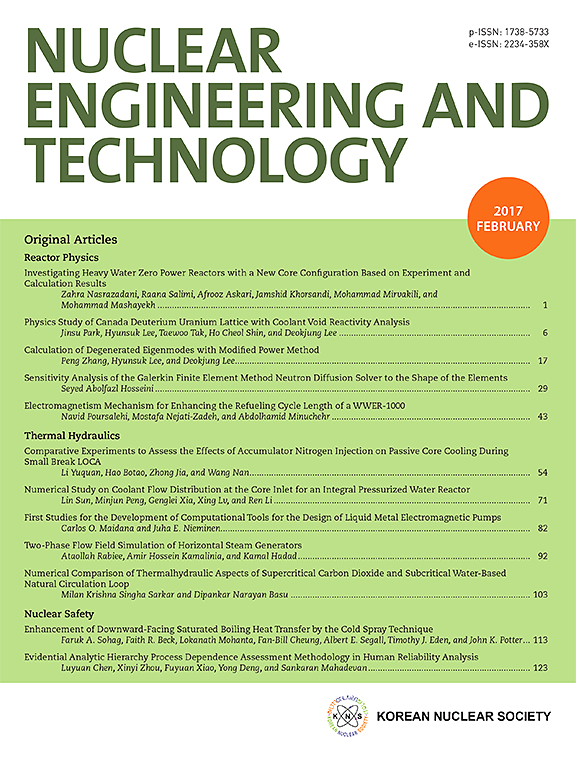Enhanced oxidative sulfuric acid leaching of granite-type uranium ore by oxygen nanobubbles: Kinetics and mechanism
IF 2.6
3区 工程技术
Q1 NUCLEAR SCIENCE & TECHNOLOGY
引用次数: 0
Abstract
Developing eco-friendly and highly efficient uranium-enhanced leaching technologies is crucial for ensuring the reliable supply of uranium resources. This study integrates nanobubble (NB) technology into the acid leaching process of granite-type uranium ore by employing oxygen NBs as an effective, clean oxidant to enhance uranium leaching. The feasibility of using oxygen NBs was first validated theoretically, and subsequent batch experiments were conducted to investigate the enhanced leaching kinetics and mechanism. The results demonstrate that oxygen NB-enhanced leaching follows a shrinking core model dominated by product layer diffusion, with an Arrhenius activation energy of 8.37 kJ/mol. Under optimal conditions (15 g/L H2SO4, 180 rpm, 5 % pulp density, and 30 °C), oxygen NBs increased uranium leaching efficiency by 8.20 % compared to conventional sulfuric acid leaching. Three key mechanisms contribute to this enhancement: (i) efficient oxidation of U(IV) to U(VI) via continuous dissolution of molecular oxygen and generation of hydroxyl radicals; (ii) expansion of leaching pathways through high-energy microarea effects that further disrupt the ore structure; and (iii) reduction of leaching inhibition by preventing sulfate precipitate deposition on mineral surfaces. These findings underscore the potential of oxygen NB-enhanced oxidative leaching for sustainable, cost-effective uranium extraction, warranting pilot-scale studies for industrial application.
氧纳米泡强化花岗岩型铀矿石氧化硫酸浸出:动力学与机理
开发生态友好、高效的铀强化浸出技术是确保铀资源可靠供应的关键。将纳米泡技术应用于花岗岩型铀矿石的酸浸过程中,利用含氧纳米泡作为高效、清洁的氧化剂,提高铀的酸浸效果。首先从理论上验证了使用氧NBs的可行性,然后进行了批量实验,研究了强化浸出的动力学和机理。结果表明:氧nb强化浸出过程遵循以产物层扩散为主的缩核模式,Arrhenius活化能为8.37 kJ/mol;在最佳条件(15 g/L H2SO4, 180 rpm, 5%矿浆密度,30°C)下,与常规硫酸浸出相比,氧NBs的铀浸出效率提高了8.20%。促进这种增强的三个关键机制:(i)通过分子氧的持续溶解和羟基自由基的产生,将U(IV)有效氧化为U(VI);(ii)通过高能微区效应扩大浸出途径,进一步破坏矿石结构;(3)通过防止硫酸盐沉淀物在矿物表面沉积来降低浸出抑制作用。这些发现强调了氧nb增强氧化浸出在可持续的、具有成本效益的铀提取方面的潜力,值得进行工业应用的中试规模研究。
本文章由计算机程序翻译,如有差异,请以英文原文为准。
求助全文
约1分钟内获得全文
求助全文
来源期刊

Nuclear Engineering and Technology
工程技术-核科学技术
CiteScore
4.80
自引率
7.40%
发文量
431
审稿时长
3.5 months
期刊介绍:
Nuclear Engineering and Technology (NET), an international journal of the Korean Nuclear Society (KNS), publishes peer-reviewed papers on original research, ideas and developments in all areas of the field of nuclear science and technology. NET bimonthly publishes original articles, reviews, and technical notes. The journal is listed in the Science Citation Index Expanded (SCIE) of Thomson Reuters.
NET covers all fields for peaceful utilization of nuclear energy and radiation as follows:
1) Reactor Physics
2) Thermal Hydraulics
3) Nuclear Safety
4) Nuclear I&C
5) Nuclear Physics, Fusion, and Laser Technology
6) Nuclear Fuel Cycle and Radioactive Waste Management
7) Nuclear Fuel and Reactor Materials
8) Radiation Application
9) Radiation Protection
10) Nuclear Structural Analysis and Plant Management & Maintenance
11) Nuclear Policy, Economics, and Human Resource Development
 求助内容:
求助内容: 应助结果提醒方式:
应助结果提醒方式:


